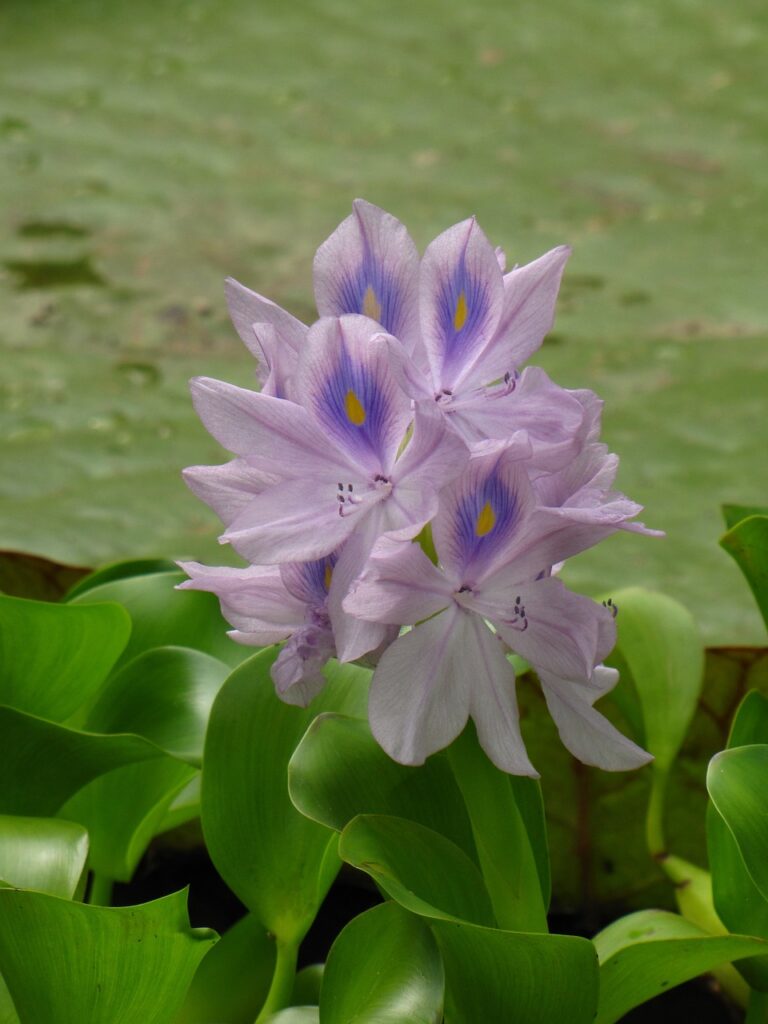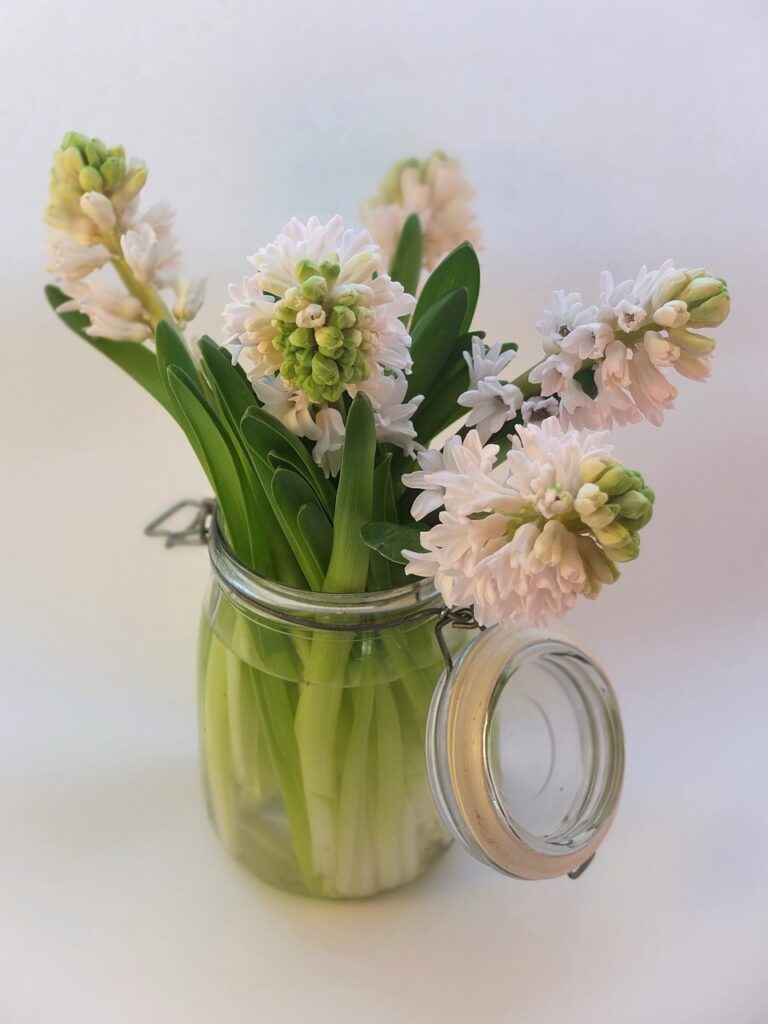You’ve probably seen them floating on the surface of lakes and ponds, their vibrant purple flowers creating a stunning sight. But have you ever wondered what exactly are water hyacinth? These aquatic plants, also known as Eichhornia crassipes, are not just mere decorations in water bodies. In fact, they are fast-growing invaders that have the potential to wreak havoc on ecosystems around the world. Let’s take a closer look at the characteristics and consequences of water hyacinth’s presence, and explore the challenges in managing this invasive species.

Water Hyacinth Description
Water hyacinth (Eichhornia crassipes) is an aquatic plant species known for its vibrant purple flowers and glossy, dark green leaves. It is a floating plant with roots that dangle in the water. The plant’s stems are long and buoyant, allowing it to float on the water’s surface. Water hyacinth is characterized by its ability to reproduce rapidly, forming dense and expansive mats on the water. These mats often cover large areas and can impede the movement of boats and other aquatic vessels.
Physical Appearance
Water hyacinth has large, round leaves that can grow up to six inches in diameter. The glossy leaves are attached to air-filled petioles, which enable the plant to stay afloat. The roots, which are often submerged in water, are feathery and provide stability to the plant. The most striking feature of water hyacinth is its beautiful flowers. The flowers are typically lavender-blue or violet in color and grow on a tall stalk above the water’s surface.
Life Cycle and Growth Habit
Water hyacinth is a perennial plant that reproduces both sexually and asexually. It can reproduce through seeds, but most commonly, it reproduces vegetatively through stolons or runners. These stolons develop new plants when they come in contact with water or moist soil. Each new plant forms a dense network of interconnected growth, quickly multiplying and creating extensive mats on the water’s surface.
Native Habitat
Water hyacinth is native to the Amazon basin in South America. It thrives in tropical and subtropical regions with a high water temperature and abundant sunlight. The plant prefers stagnant or slow-moving water bodies like lakes, ponds, and marshes.
Global Distribution
Water hyacinth has spread beyond its native habitat and is now found in many parts of the world. It is considered one of the most invasive plant species globally. It has been introduced intentionally or accidentally to various countries for its aesthetic value, use in ponds and aquariums, or in the hope of controlling water pollution. Today, water hyacinth can be found in regions of Africa, Asia, Europe, and North America, where its rapid growth and ability to outcompete native vegetation pose significant ecological and economic challenges.
Significance of Water Hyacinth
Environmental Impact
The dense mats of water hyacinth floating on the water’s surface have several adverse environmental impacts. Firstly, these mats block sunlight from reaching the submerged plants below, thereby disrupting the natural aquatic ecosystem. This reduction in sunlight can lead to reduced oxygen levels in the water, affecting fish and other aquatic organisms’ survival. Additionally, water hyacinth mats create stagnant areas, which become breeding grounds for mosquitoes, increasing the risk of waterborne diseases.
Economic Impact
The economic impact of water hyacinth is substantial. Its dense mats pose a significant threat to waterways, obstructing navigation and disrupting transportation and recreational activities such as boating, fishing, and tourism. These mats can clog irrigation canals, water intakes for power plants, and infrastructure used for water supply, causing operational problems and increased maintenance costs. Moreover, the presence of water hyacinth in water bodies can negatively affect the aesthetics, leading to reduced property values and decreased attractiveness for waterfront communities.
Causes and Factors for Water Hyacinth Growth
Nutrient Pollution
Water hyacinth thrives in nutrient-rich water bodies, especially those polluted with excessive levels of nitrogen and phosphorous. These nutrients primarily come from domestic and industrial wastewater, agricultural runoff, or improper disposal of sewage. High nutrient levels promote the rapid growth and reproduction of water hyacinth, creating favorable conditions for its invasion.
Climate Factors
Water hyacinth prefers warm temperatures above 15°C (59°F) and abundant sunlight. In regions with a tropical or subtropical climate, these conditions are present for most of the year, providing an optimal environment for rapid growth. Adequate rainfall can also contribute to the plant’s expansion by providing the necessary water for its survival and reproduction.
Aquatic Ecosystem Disturbance
Human activities such as dam construction, dredging, and water diversion can disrupt aquatic ecosystems. These disturbances can create open spaces and expose sediments, providing an ideal environment for water hyacinth colonization. Human-induced disturbances can further compound the plant’s invasive tendencies, facilitating its rapid expansion and dominance in affected water bodies.
Effects of Water Hyacinth
Ecological Effects
The dense mats of water hyacinth have severe ecological effects on aquatic ecosystems. They reduce the availability of sunlight to submerged plants, hindering their growth and productivity. This reduction in plant productivity can disrupt the food chain, affecting herbivores, carnivores, and decomposers that rely on aquatic vegetation. Furthermore, the mats alter the physical structure of the water bodies, creating stagnant areas and depleting oxygen levels, which can lead to fish kills and the decline of other aquatic organisms.
Economic Effects
The economic effects of water hyacinth infestations are extensive. As mentioned earlier, the plant obstructs waterways, impeding transportation, and recreational activities. This can have substantial impacts on local economies that rely on boating, fishing, and tourism. In agriculture, water hyacinth can clog irrigation canals, affecting the availability of water for crop production. Moreover, controlling and managing water hyacinth requires significant financial resources, adding to the economic burden.
Human Health Effects
Water hyacinth can indirectly affect human health by creating favorable conditions for mosquito breeding. The plant’s dense mats provide shelter and organic matter, which promote the breeding of mosquitoes that transmit diseases such as malaria, dengue fever, and Zika virus. Additionally, the presence of water hyacinth can hamper access to clean water sources, potentially leading to waterborne diseases and compromising sanitation.

Control and Management of Water Hyacinth
Mechanical Methods
Various mechanical methods can be employed to control water hyacinth infestations. These include manual removal by hand pulling or using specialized machinery to cut and harvest the plants. Regular removal of the plants can help prevent further spread and reduce the plant population. Mechanical methods are often labor-intensive and may require frequent maintenance to prevent the reestablishment of water hyacinth.
Chemical Control
Chemical control methods involve the use of herbicides specifically designed to target water hyacinth. These herbicides are applied directly to the plant, either by spraying or injecting into the plant’s stems or leaves. Chemical control is effective in killing and suppressing water hyacinth, but it requires careful application to minimize its impact on non-target species and the surrounding environment. Proper training and adherence to regulations are necessary when using chemical control methods.
Biological Control
Biological control involves the introduction of natural enemies or predators of water hyacinth to reduce its population. Several insects, such as weevils and moth larvae, have been introduced as biological control agents. These insects feed on water hyacinth, reducing its growth and ability to reproduce. Biological control methods aim to establish a natural balance between the water hyacinth population and its natural enemies, keeping the plant’s growth in check without causing harm to non-target species.
Uses of Water Hyacinth
Wastewater Treatment
Despite its negative impacts, water hyacinth can be beneficial in some contexts. It is an effective phytoremediation tool for wastewater treatment. The plant’s extensive root system can absorb excess nutrients and pollutants from water bodies, helping to improve water quality. Many water treatment facilities utilize water hyacinth as a natural filtration system to remove pollutants and enhance the treatment process.
Livestock Feed
Water hyacinth can be used as a nutritious feed source for livestock, especially ruminants like cattle and goats. The plant is high in protein content and can be dried and used as supplementary feed during times of feed scarcity. However, caution must be exercised as high quantities of water hyacinth can lead to digestive disorders in animals. Proper processing and controlled feeding methods are essential.
Craft Materials
Water hyacinth has also found applications in the craft industry. The plant’s stems and leaves can be dried and woven to create baskets, mats, furniture, and decorative items. The craftsmanship utilizing water hyacinth provides livelihood opportunities for communities living in areas heavily infested with the plant. The use of water hyacinth in crafts promotes sustainable utilization and helps mitigate the plant’s negative impacts.
Biofuel
Water hyacinth can serve as a potential source of biofuel, particularly through anaerobic digestion or fermentation. The plant contains a high amount of biomass, which can be converted into biogas or bioethanol. Utilizing water hyacinth for biofuel production not only provides an alternative energy source but also helps in tackling the plant’s invasive growth by harvesting and utilizing it for a productive purpose.

Invasive Species Concerns
Introduction and Spread
Water hyacinth has established itself as one of the world’s most invasive plant species due to various human-mediated introductions. Garden and pond enthusiasts often introduce the plant intentionally, unaware of its invasive nature. Additionally, accidental dispersal occurs through river and canal systems, where fragments of the plant can detach and float downstream, establishing new populations. The plant’s ability to reproduce rapidly and its adaptability to various environmental conditions contribute to its successful spread.
Impacts on Biodiversity
Water hyacinth’s invasion can have significant impacts on biodiversity. It outcompetes native aquatic vegetation, reducing plant species diversity and altering habitat structure. This, in turn, affects a wide range of organisms that rely on aquatic vegetation for food, shelter, and reproduction. Reduction in native biodiversity can disrupt ecosystem functioning and ultimately lead to cascading effects throughout the food web.
Control Efforts
Numerous efforts have been made to control and manage water hyacinth infestations. Integrated management approaches combining mechanical, chemical, and biological control methods have been implemented in various regions. Additionally, public awareness campaigns and education programs aim to educate communities about the risks of introducing and spreading water hyacinth. Continued research and monitoring are essential to develop effective control strategies and prevent further spread.
Research and Ongoing Studies
Ecological Research
Ongoing ecological research focuses on understanding the impacts of water hyacinth on aquatic ecosystems and developing strategies to mitigate these impacts. Studies examine the plant’s interactions with other species, its effects on water quality, and the long-term ecological consequences of its invasion. Additionally, research investigates the potential ecological benefits of utilizing water hyacinth as a tool for wastewater treatment and habitat restoration.
Control Techniques Development
Scientists and researchers are continuously studying and developing new control techniques to combat water hyacinth infestations. This includes exploring innovative mechanical methods, enhancing the effectiveness and safety of chemical control, and evaluating the efficacy of introduced biological control agents. The development of sustainable, cost-effective, and environmentally friendly control techniques is crucial to effectively manage water hyacinth and minimize its negative impacts.
Sustainable Utilization
Efforts are being made to explore and promote the sustainable utilization of water hyacinth. Research is focused on discovering new uses for the plant, such as biodegradable packaging materials, fertilizers, and pharmaceutical applications. By finding valuable applications for water hyacinth, its management can be transformed into a more sustainable and economically beneficial practice, providing incentives for its control and utilization.
Conclusion
Water hyacinth, with its striking appearance and rapid growth, presents both challenges and opportunities. The plant’s ability to form dense mats on water bodies has significant environmental and economic impacts, disrupting aquatic ecosystems and hindering human activities. However, through effective control measures and sustainable utilization, water hyacinth can be managed and even transformed into a valuable resource. Ongoing research and collaborative efforts are crucial in developing strategies to address the global issue posed by this invasive species, ensuring a healthier and more sustainable future for our water bodies and ecosystems.